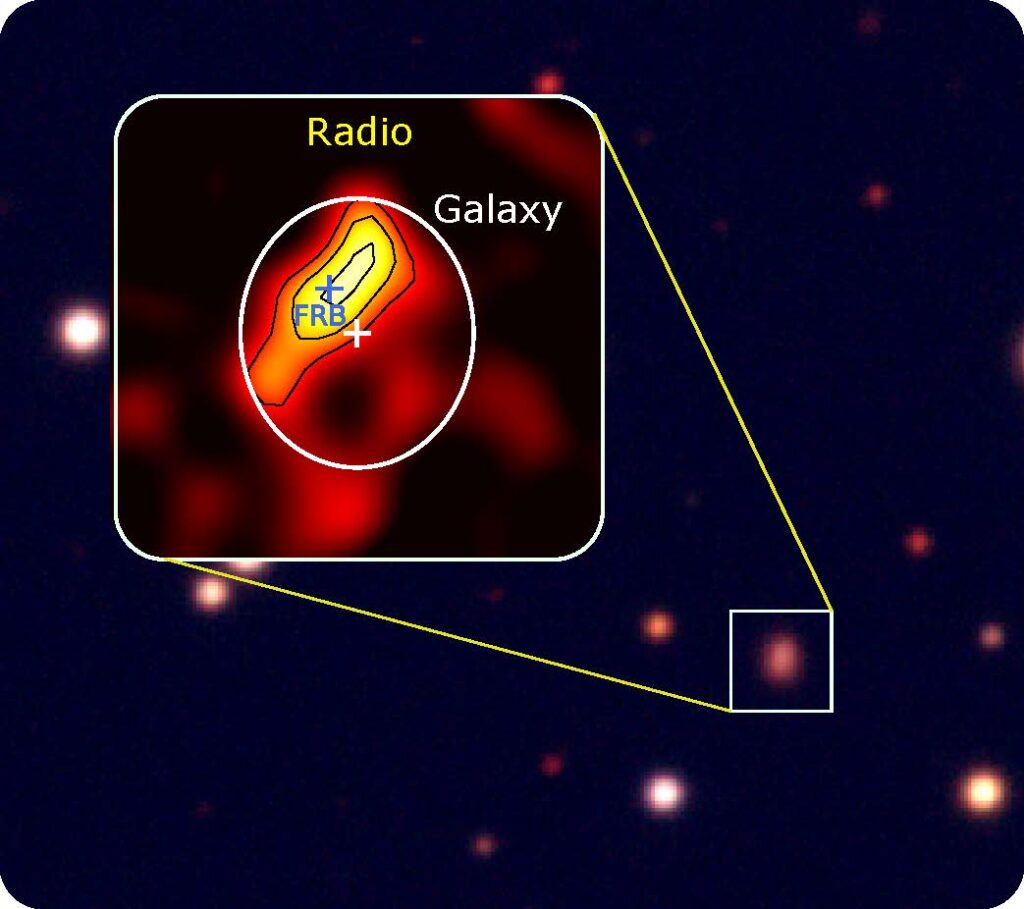With a multiwavelength campaign, a group of astronomers led by the Italian National Institute of Astrophysics (INAF) studied a repeating fast radio burst (FRB). The object FRB20201124A, discovered in November 2020, reactivated in March 2021, emitting a series of radio bursts. It is also the third repeating FRB recently localized in a nearby galaxy. The observations, reported in an Astronomy & Astrophysics article, started in April 2021 with nine facilities from ground and space: the X-ray observatories Swift and Chandra, the Very Large Array (VLA), the European VLBI Network (EVN), the e-Merlin telescope, the Five hundred meter Aperture Spherical Telescope (FAST), the Lowell Discovery Telescope (LDT), the Upgraded Giant Metrewave Radio Telescope (uGMRT) and the INAF’s Sardinia Radio Telescope (SRT).

Fast radio bursts are unique and mysterious phenomena in the Universe. Discovered by radio astronomers in 2007, their origin is still unknown. These events produce intense radio wave emissions that last only a few milliseconds before disappearing. FRBs release an amount of energy that makes them visible even at cosmological distances. After discovering the so-called repeating FRBs (fast radio bursts that repeat the emission even months after their first observation), the scientific community gathered around the theory that magnetars (a particular class of neutron stars) are the most likely origin for repeating FRBs. Magnetars are the most powerful magnets in the Universe, and they are known to emit short bursts of gamma rays that last less than a second but are billions of times brighter than the Sun.
Luigi Piro, a researcher at INAF and first author of the article, explains: “We created a radio image of the host galaxy of the FRB, discovering that the location previously provided by other authors corresponds with a region of diffuse radio emission, a hotbed of star-birth activity. We also caught a glimpse of X-rays coming from the same region”.
Gabriele Bruni, also from INAF, adds: “The origin of FRBs is one of the mysteries of modern-day astrophysics. Repeating FRBs offer the possibility of pointing the telescopes at the position we already know. As a result, we can use telescopes at different multiwavelength with an accuracy that would otherwise be impossible. In our case, we have privileged relatively nearby objects (at distances less than about 1.3 billion light-years) to be able to zoom in on the radio flashes and their surroundings on scales of several hundred light-years “.
“Our optical observations confirm the presence of recent star-birth. These multiwavelength data point to the possible progenitor of FRBs, a baby neutron star born from a supernova explosion and endowed with a magnetic field a trillion times stronger than the Earth’s,” Eleonora Troja (the University of Maryland, now at the University of Tor Vergata in Rome) says. Troja was responsible for the observations in visible light with LDT and for analyzing the X-ray data with Chandra.
Researchers used the radio band interferometric technique: by combining the signal from multiple antennas, it is possible to obtain the equivalent resolution of an antenna with a diameter equal to their distance. Further higher resolution observations are still underway to characterize the portion of the galaxy that hosts the fast radio burst even more in detail.
“Discovered about ten years ago, fast radio bursts are one of the recent mysteries of Astrophysics. In recent years, the technological improvements of radio telescopes allowed us to gather hints linking their origin to extreme objects in the Universe, like fast-spinning neutron stars with extreme magnetic fields. Their brief emission is reminiscent of Gamma-Ray Bursts, another long-standing mystery of Astrophysics, multiwavelength observations eventually solved that”, Piro adds.
“Alongside the interferometers, using a large single disc radio telescopes such as FAST and our Sardinia Radio Telescope,” Marta Burgay, a researcher at INAF and author of the article, concludes, “is essential to identify and measure the arrival time of these very short radio bursts, to be able to verify the possible simultaneous presence of similar events at other wavelengths. The simultaneous observation of the signal of an FRB in different portions of the electromagnetic spectrum is a fundamental path to follow to obtain crucial clues for understanding the origin of this strange astrophysical phenomenon”.
This work led by Dr. Luigi Piro from the Italian National Institute of Astrophysics (INAF) was accepted for publication in Astronomy & Astrophysics with the title: “The fast radio burst FRB 20201124A in a star-forming region: Constraints to the progenitor and multiwavelength counterparts”. Co-authors: G. Bruni, E. Troja, B. O’Connor, F. Panessa, R. Ricci, B. Zhang, M. Burgay, S. Dichiara, K. J. Lee, S. Lotti, J. R. Niu, M. Pilia, A. Possenti, M. Trudu, H. Xu, W. W. Zhu, A. S. Kutyrev and S. Veilleux. This work can be found here: https://www.aanda.org/articles/aa/full_html/2021/12/aa41903-21/aa41903-21.html
Source: http://www.inaf.it/en/inaf-news/frb-20201124a
